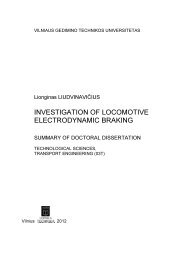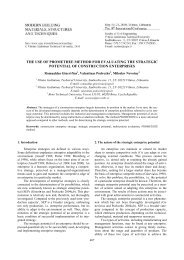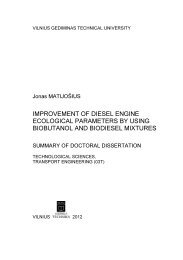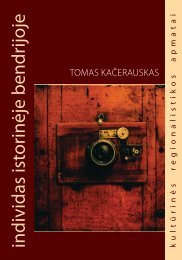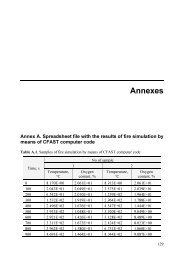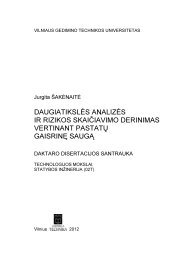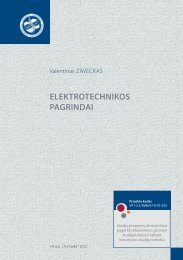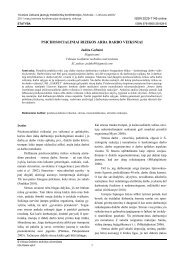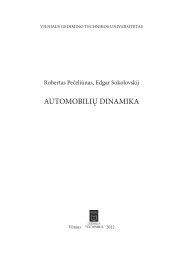investigation of total ozone amount and development of its research ...
investigation of total ozone amount and development of its research ...
investigation of total ozone amount and development of its research ...
You also want an ePaper? Increase the reach of your titles
YUMPU automatically turns print PDFs into web optimized ePapers that Google loves.
Disertacija rengta 2007–2012 metais Vilniaus Gedimino technikos universitete.Mokslinis vadovaspr<strong>of</strong>. dr. Aloyzas GIRGŽDYS (Vilniaus Gedimino technikos universitetas,technologijos mokslai, aplinkos inžinerija – 04T).Konsultantaspr<strong>of</strong>. dr. Artūras JUKNA (Vilniaus Gedimino technikos universitetas,fiziniai mokslai, fizika – 02P).Disertacija ginama Vilniaus Gedimino technikos universiteto Aplinkosinžinerijos mokslo krypties taryboje:Pirmininkaspr<strong>of</strong>. dr. Saulius VASAREVIČIUS (Vilniaus Gedimino technikosuniversitetas, technologijos mokslai, aplinkos inžinerija – 04T).Nariai:dr. Steigvilė BYČENKIENĖ (Valstybinis mokslinių tyrimų institutasFizinių ir technologijos mokslų centras, fiziniai mokslai, fizika – 02P),doc. dr. Jonas GRADAUSKAS (Valstybinis mokslinių tyrimų institutasFizinių ir technologijos mokslų centras, fiziniai mokslai, fizika – 02P),pr<strong>of</strong>. habil. dr. Vytenis Albertas ZABUKAS (Klaipėdos universitetas,technologijos mokslai, aplinkos inžinerija – 04T),dr. Alvydas ZAGORSKIS (Vilniaus Gedimino technikos universitetas,technologijos mokslai, aplinkos inžinerija – 04T).Oponentai:doc. dr. Egidijus RIMKUS (Vilniaus universitetas, fiziniai mokslai, fizinėgeografija – 06P),pr<strong>of</strong>. habil. dr. Dmitrijus STYRO (Vilniaus Gedimino technikosuniversitetas, technologijos mokslai, aplinkos inžinerija – 04T).Disertacija bus ginama viešame Aplinkos inžinerijos mokslo krypties tarybosposėdyje 2013 m. sausio 14 d. 14 val. Vilniaus Gedimino technikos universitetosenato posėdžių salėje.Adresas: Saulėtekio al. 11, LT-10223 Vilnius, Lietuva.Tel.: (8 5) 274 4952, (8 5) 274 4956; faksas (8 5) 270 0112;el. paštas doktor@vgtu.ltDisertacijos santrauka išsiuntinėta 2012 m. gruodžio 13 d.Disertaciją galima peržiūrėti Vilniaus Gedimino technikos universitetobibliotekoje (Saulėtekio al. 14, LT-10223 Vilnius, Lietuva).VGTU leidyklos „Technika“ 2083-M mokslo literatūros knyga.© Sergejus Tretjakovas, 2012
IntroductionFormulation <strong>of</strong> the problem. The <strong>total</strong> <strong>ozone</strong> <strong>amount</strong> in the atmosphere isdetermined only under conditions <strong>of</strong> clear sky <strong>and</strong> low nebulosity. Therefore, itis impossible to carry out the continuous (daily) data record <strong>of</strong> <strong>total</strong> <strong>ozone</strong><strong>amount</strong> due to the weather conditions. There is little scientific information on<strong>total</strong> <strong>ozone</strong> <strong>amount</strong> studies in Lithuania made, there are no comprehensive <strong>and</strong>methodologically sound studies on short-term changes in <strong>total</strong> <strong>ozone</strong> <strong>amount</strong>over the territory <strong>of</strong> Lithuania.Artificial Earth Satellites are also used for the monitoring <strong>of</strong> <strong>total</strong> <strong>ozone</strong><strong>amount</strong>. These satellite measurements can be used as additional information forthe assessment <strong>of</strong> thickness <strong>of</strong> the <strong>ozone</strong> layer, <strong>and</strong> especially for thedetermination <strong>of</strong> strong depletions <strong>and</strong> prognosis, but there is no system thatcombines all the available information. Moreover, for the assessment <strong>of</strong>detailed changes, the assessment <strong>of</strong> thickness <strong>of</strong> the <strong>ozone</strong> layer once per day isinsufficient. Measurement data <strong>of</strong> foreign countries are not used in Lithuaniasince the results <strong>of</strong> the <strong>total</strong> <strong>ozone</strong> <strong>amount</strong> measured are not adapted for theassessment.One <strong>of</strong> the pending issues in the world is prevention <strong>and</strong> control <strong>of</strong>depletion <strong>of</strong> the <strong>ozone</strong> layer <strong>and</strong> protection <strong>of</strong> existing biodiversity on the Earthfrom harmful exposure <strong>of</strong> ultraviolet radiation. This requires a detailed analysis<strong>of</strong> changes in the <strong>ozone</strong> layer which can be done only after having improvedmethods <strong>and</strong> equipment used through the creation <strong>of</strong> continuous measurementsystem for the monitoring <strong>of</strong> changes in <strong>total</strong> <strong>ozone</strong> <strong>amount</strong>.The topicality <strong>of</strong> the thesis. Issues related to the changes in the <strong>ozone</strong>layer <strong>and</strong> the origin <strong>of</strong> the <strong>ozone</strong> holes become important <strong>and</strong> relevant globally.Amount <strong>of</strong> <strong>ozone</strong> molecules in the atmosphere is relatively very low. Thedepletion <strong>of</strong> the <strong>ozone</strong> layer by 1 % is proportional to approximately 2 % <strong>of</strong> theultraviolet radiation (UV) <strong>of</strong> 280–320 nm wavelength increase in intensity atthe Earth's surface.Therefore, more than ever, the attention must be paid to the <strong>research</strong>es <strong>of</strong>the <strong>ozone</strong> layer <strong>and</strong> <strong>development</strong> <strong>of</strong> <strong>research</strong> methods in today's environmentalissues. It should be noted that to achieve these goals it is relevant to identify<strong>and</strong> assess the dynamics <strong>of</strong> changes in <strong>total</strong> <strong>ozone</strong> <strong>amount</strong>, to improve <strong>research</strong>methods <strong>and</strong> instruments.In order to fully ascertain the reasons for the decrease <strong>and</strong> increase in <strong>total</strong><strong>ozone</strong> <strong>amount</strong>, it is important to have continuous data on <strong>its</strong> overgroundchanges. There is little scientific literature on short-term (e.g. day, hour)changes in <strong>total</strong> <strong>ozone</strong> <strong>amount</strong>. In addition, there are no possibilities toaccurately measure <strong>its</strong> <strong>amount</strong> in the atmosphere every day. Therefore, taking5
into account the following, it is relevant to find other ways <strong>of</strong> determination <strong>of</strong><strong>total</strong> <strong>ozone</strong> <strong>amount</strong> <strong>and</strong> expansion <strong>of</strong> determination possibilities.The object <strong>of</strong> the <strong>research</strong>. The object <strong>of</strong> the <strong>research</strong> is the <strong>total</strong> <strong>ozone</strong><strong>amount</strong> <strong>and</strong> methods for <strong>its</strong> determination.The aim <strong>of</strong> the work – to assess the changes in <strong>total</strong> <strong>ozone</strong> <strong>amount</strong> <strong>and</strong> toimprove the <strong>research</strong> methodology through the expansion <strong>of</strong> the possibilitiesfor determination <strong>of</strong> <strong>total</strong> <strong>ozone</strong> <strong>amount</strong>.The tasks <strong>of</strong> the work1. To create an improved measurement method using ozonometerMicrotops II <strong>and</strong> to exp<strong>and</strong> possibilities for the determination <strong>of</strong> <strong>total</strong><strong>ozone</strong> <strong>amount</strong>.2. To carry out studies on short-term changes in <strong>total</strong> <strong>ozone</strong> <strong>amount</strong>under different meteorological conditions <strong>and</strong> to assess fluctuations<strong>of</strong> changes in the latitudes <strong>of</strong> Lithuania.3. To examine on-going changes in <strong>total</strong> <strong>ozone</strong> <strong>amount</strong> in Lithuania <strong>and</strong>neighbouring countries, to assess data use options <strong>of</strong> other countriesfor the determination <strong>of</strong> <strong>total</strong> <strong>ozone</strong> <strong>amount</strong> over the territory <strong>of</strong>Lithuania.4. To develop mathematical model for the assessment <strong>of</strong> <strong>total</strong> <strong>ozone</strong><strong>amount</strong>, using results on measurements <strong>of</strong> <strong>total</strong> <strong>ozone</strong> <strong>amount</strong> carriedout by the neighbouring countries.Methodology <strong>of</strong> <strong>research</strong>. Researches on <strong>total</strong> <strong>ozone</strong> <strong>amount</strong> were carriedout using an improved method <strong>of</strong> measurement with an automatedmeasurement system. In order to theoretically determine the <strong>total</strong> <strong>ozone</strong> <strong>amount</strong>in Lithuania <strong>and</strong> to assess <strong>its</strong> changes, measurement results received from theneighbouring countries surrounding Lithuania <strong>and</strong> Artificial Earth Satellitehave been applied.Scientific novelty. Both improved methods <strong>and</strong> developed equipmentsignificantly exp<strong>and</strong> possibilities for the <strong>research</strong>es <strong>of</strong> <strong>total</strong> <strong>ozone</strong> <strong>amount</strong>.Complex <strong>research</strong>es related to the determination <strong>of</strong> <strong>total</strong> <strong>ozone</strong> <strong>amount</strong> havebeen carried out, <strong>and</strong> short-term <strong>and</strong> long-term changes in <strong>total</strong> <strong>ozone</strong> <strong>amount</strong>over Lithuania have been studied <strong>and</strong> assessed.Integrated method for the determination <strong>of</strong> <strong>total</strong> <strong>ozone</strong> <strong>amount</strong> usingmeasurement results received in Lithuania <strong>and</strong> from <strong>its</strong> surrounding countries,Artificial Earth Satellites <strong>and</strong> automated measurement system has beendeveloped.6
Practical value. Designed automated measurement system can be appliedfor the determination <strong>of</strong> <strong>total</strong> <strong>ozone</strong> <strong>amount</strong> <strong>and</strong> assessment <strong>of</strong> changes inpractice, continuous monitoring <strong>of</strong> the <strong>ozone</strong> layer <strong>and</strong> in particularidentification <strong>of</strong> the holes formed in the <strong>ozone</strong> layer in real-time <strong>and</strong> prediction.Using the developed methodology, timely determinations <strong>of</strong> intense ultravioletradiation episodes can be carried out <strong>and</strong> timely warning about their dangerouslevels can be made as well.There is the presentation <strong>of</strong> expansion possibilities for the measurements<strong>of</strong> <strong>total</strong> <strong>ozone</strong> <strong>amount</strong>. The thesis covers examination <strong>of</strong> changes in <strong>total</strong> <strong>ozone</strong><strong>amount</strong> over Lithuania <strong>and</strong> neighbouring countries in 1993–2008, <strong>and</strong> theirrelationship is given. Summarized <strong>research</strong> results show that fluctuationssequence <strong>of</strong> <strong>total</strong> <strong>ozone</strong> <strong>amount</strong> can be seen <strong>and</strong> their change processes can bepredicted as well. Practical implication <strong>of</strong> proposed work methodology is thepossibility to assess the changes in <strong>total</strong> <strong>ozone</strong> <strong>amount</strong> over the territory <strong>of</strong>Lithuania, using measurement results accumulated by <strong>its</strong> neighbouringcountries.Thesis statements1. The exact <strong>total</strong> <strong>ozone</strong> <strong>amount</strong> over the territory <strong>of</strong> Lithuania can bedetermined from the measurement results on <strong>total</strong> <strong>ozone</strong> <strong>amount</strong> carried outby the neighbouring countries surrounding Lithuania by using the method <strong>of</strong>least quadrates (optimal interpolation). The accuracy <strong>of</strong> the method in 95%<strong>of</strong> the cases is not less than 8% deviation from the true values <strong>of</strong> <strong>total</strong> <strong>ozone</strong><strong>amount</strong>.2. The continuous measurements with automated system give the ability tomeasure more than 1 % deviation from the true <strong>total</strong> <strong>ozone</strong> <strong>amount</strong> values.3. When accumulations (clouds) <strong>of</strong> water droplets or ice crystals block theoptical measurement path, <strong>total</strong> <strong>ozone</strong> <strong>amount</strong> <strong>and</strong> <strong>its</strong> changes may bemeasured by using solar tracking device.The scope <strong>of</strong> the scientific work. The thesis consists <strong>of</strong> an introduction, fivemain chapters, general conclusions <strong>and</strong> recommendations, list <strong>of</strong> references <strong>and</strong> list<strong>of</strong> the author’s publications. The <strong>total</strong> scope <strong>of</strong> the thesis is 126 pages, 36 numberedformulas, 69 pictures, 9 tables. 86 sources <strong>of</strong> literature were cited in the thesis. Theresults <strong>of</strong> the thesis are published in 6 publications. The results were presented in 5national conferences.Chapter 1 is intended for the review <strong>of</strong> literature. The chapter presentsreview <strong>of</strong> the <strong>total</strong> <strong>ozone</strong> <strong>amount</strong>, the factors affecting <strong>its</strong> changes, causes <strong>of</strong> thedepletion <strong>of</strong> the <strong>ozone</strong> layer <strong>and</strong> origins <strong>of</strong> the <strong>ozone</strong> holes. In chapter 2 method<strong>and</strong> device for measuring <strong>total</strong> <strong>ozone</strong> <strong>amount</strong> are described. It presentsimproved method for the determination <strong>of</strong> <strong>total</strong> <strong>ozone</strong> <strong>amount</strong> using an7
automated measurement system. Chapter 3 describes experimental results onthe determination <strong>of</strong> <strong>total</strong> <strong>ozone</strong> <strong>amount</strong> using an automated measurementsystem <strong>and</strong> expansion <strong>of</strong> measurement possibilities. It provides short-termexperimental studies using an integrated monitoring system. Chapter 4describes long-term changes in <strong>total</strong> <strong>ozone</strong> <strong>amount</strong> over Lithuania <strong>and</strong>neighbouring countries. It deals with the possibilities for determination <strong>of</strong> <strong>total</strong><strong>ozone</strong> <strong>amount</strong> in Lithuania, using measurement results <strong>of</strong> other countries.Chapter 5 describes additional device created for the studies <strong>of</strong> the changes in<strong>total</strong> <strong>ozone</strong> <strong>amount</strong> – automated measuring system <strong>and</strong> <strong>its</strong> equipment.1. The <strong>total</strong> <strong>ozone</strong> <strong>amount</strong> <strong>and</strong> their changes in the atmosphereSystematic measurement <strong>of</strong> <strong>total</strong> <strong>ozone</strong> <strong>amount</strong> has been started relativelyrecently. The salient depletion <strong>of</strong> the <strong>ozone</strong> layer is observable above theAntarctic. However, the recent trends <strong>of</strong> depletion are more visible above themiddle latitudes, too. Approximately 99% <strong>of</strong> UV solar radiation (UV C, <strong>and</strong> thegreater part <strong>of</strong> the UV B sector) is absorbed by stratospheric <strong>ozone</strong>. This is anatural protective function created by the nature to protect us from harmfuleffect <strong>of</strong> ultraviolet rays. Main advantage <strong>of</strong> overground devices is a moreaccurate determination <strong>of</strong> <strong>total</strong> <strong>ozone</strong> <strong>amount</strong> values. However, most <strong>of</strong> themare morally outdated <strong>and</strong> bulky, require high financial cost. In addition, it is notpossible to use them every day due to the weather conditions. Measurementresults using Artificial Earth Satellite have large errors, <strong>and</strong> their maintenancerequires high financial cost.2. Methods <strong>and</strong> tools for the <strong>research</strong>es <strong>of</strong> <strong>total</strong> <strong>ozone</strong> <strong>amount</strong>For the TOA measurements, portable ozonometer Microtops II has beenchosen. It is used to measure <strong>total</strong> <strong>ozone</strong> <strong>amount</strong> in the atmosphere from theEarth surface by precisely directing it to the sun. This device has a high-qualitystable filters that register sunlight wavelengths <strong>of</strong> 305 nm, 312 nm <strong>and</strong> 320 nm.Ozonometer programme calculates the <strong>total</strong> <strong>ozone</strong> <strong>amount</strong> using the Lambert-Beer's law:−αµΩ−mβP/ PI = I00e,(1)where: I 0 – intensity <strong>of</strong> a specific light ray wavelength before passing throughthe atmosphere; I – intensity <strong>of</strong> the light rays which passed the atmosphere;µ –the ratio between the actual <strong>and</strong> vertical distance that light rays pass throughthe <strong>ozone</strong> layer; Ω – <strong>total</strong> <strong>ozone</strong> <strong>amount</strong>, DU; α – <strong>ozone</strong> absorption coefficientfor a given wavelength, P – atmospheric pressure, mB, P 0 – st<strong>and</strong>ardatmospheric pressure, mB; m – air mass which is expressed in the ratio <strong>of</strong>8
Using the TOA data received from Artificial Earth Satellites along withother results <strong>of</strong> overground measurement <strong>and</strong> experimental <strong>research</strong>es, TOAsurveillance system is formed by which complex assessments <strong>of</strong> changes withinTOA taking place in the atmosphere are assessed.3. Experimental <strong>research</strong>es <strong>of</strong> <strong>total</strong> <strong>ozone</strong> <strong>amount</strong>In cases when clouds obscure the sun, there is no possibility to direct theozonometer using the desired accuracy, <strong>and</strong> to measure the <strong>total</strong> <strong>ozone</strong> <strong>amount</strong>at the same time. In addition, due to the human factor, it is impossible to assessthe possible measurement errors when holding the ozonometer in h<strong>and</strong>s.Researches have been carried out <strong>and</strong> possibilities <strong>of</strong> the use <strong>of</strong> <strong>total</strong> <strong>ozone</strong><strong>amount</strong> measurement method, using an automated measurement system duringsunny days have been examined. The characteristic results <strong>of</strong> 15 July 2011 <strong>of</strong>one <strong>of</strong> such short–term <strong>research</strong>es are shown in Fig. 2.Fig. 2. The results <strong>of</strong> measurements on sunny days using an automated measurementsystemDuring the assessment <strong>of</strong> the experimental results, it was found that thedeveloped automated measurement system adapted to the ozonometerMicrotops II allows carrying out continuous <strong>research</strong>es <strong>of</strong> <strong>total</strong> <strong>ozone</strong> <strong>amount</strong>on sunny days. Therefore the opportunity to direct the ozonometer to the sunfor up to 3 days has been made, <strong>and</strong> during the slight corrections <strong>of</strong> movablebracket angle every three days – to perform continuous measurements. Also,the possibilities to carry out the measurements <strong>of</strong> <strong>total</strong> <strong>ozone</strong> <strong>amount</strong> at a10
out during the experimental <strong>research</strong>es shows that the accuracy on clear dayscan be up to 1% or less. When measuring with the automated measurementsystem <strong>and</strong> calculating the average daily value – the measurement accuracyincreases more. This allows the accurate determination <strong>of</strong> the <strong>total</strong> <strong>ozone</strong><strong>amount</strong> <strong>and</strong> assessment <strong>of</strong> short-term changes.When measuring short-term changes in <strong>total</strong> <strong>ozone</strong> <strong>amount</strong>, it was foundthat there are short-term fluctuations <strong>and</strong> the <strong>ozone</strong> layer during the day maychange. Compared with long-term changes in <strong>total</strong> <strong>ozone</strong> <strong>amount</strong> (per year theycan change over 200 DV or more), short-term changes are significantly lower,fluctuations <strong>of</strong> <strong>total</strong> <strong>ozone</strong> <strong>amount</strong> during October <strong>and</strong> March are the highest(up to 40 DV), in April–August – the lowest (up to 10 DV). This is to be relatedto the carries <strong>of</strong> air mass – the so-called Brewer-Dobson circulation –happening in the atmosphere, because the carries <strong>of</strong> air mass <strong>and</strong> thus <strong>of</strong> thestratospheric <strong>ozone</strong> increase during the cold season. Because <strong>of</strong> this, the casesshowing strong depletion <strong>of</strong> the <strong>ozone</strong> layer increase as well. Therefore, it isappropriate to perform continuous measurements during the cold period. Usingan automated measurement system helped to determine the changes in thevalues <strong>of</strong> <strong>total</strong> <strong>ozone</strong> <strong>amount</strong> measurements <strong>and</strong> values <strong>of</strong> ozonometer signalsevery ten seconds when signals close to the minimum values (Fig. 4).Fig. 4. Variations <strong>of</strong> results <strong>of</strong> <strong>total</strong> <strong>ozone</strong> <strong>amount</strong> due to the light absorption effectIn such cases, the device cannot measure the <strong>total</strong> <strong>ozone</strong> <strong>amount</strong> to anaccuracy defined by the manufacturer (up to 2%). When SZK is increasing, thechange <strong>of</strong> <strong>total</strong> <strong>ozone</strong> <strong>amount</strong> values is becoming greater. When assessing the12
dispersal <strong>of</strong> these results every minute, it was found that the change in <strong>total</strong><strong>ozone</strong> <strong>amount</strong> results within 11 minutes can increase by more than 9 times.Short–term <strong>research</strong>es carried out on cloudy days show that individualmeasurement results <strong>of</strong> <strong>total</strong> <strong>ozone</strong> <strong>amount</strong> may not be reliable (error greaterthan 2%) due to the properties <strong>of</strong> water crystalline collections in the atmosphereto absorb <strong>and</strong> diffuse solar light waves. Using an automated measurementsystem, these misleading results can be eliminated (Fig. 5).Fig. 5. Unreliable results <strong>of</strong> <strong>total</strong> <strong>ozone</strong> <strong>amount</strong> determined on cloudy days (marked byellipses)Fig. 6. Results <strong>of</strong> <strong>total</strong> <strong>ozone</strong> <strong>amount</strong> measurements on 8–13 January, 201213
It has been determined that using an integrated system for the monitoring<strong>of</strong> <strong>total</strong> <strong>ozone</strong> <strong>amount</strong>, it is possible to timely identify <strong>and</strong> monitor changes inthe <strong>total</strong> <strong>ozone</strong> <strong>amount</strong> <strong>and</strong> formation <strong>of</strong> <strong>ozone</strong> holes in cases when directoverground measurements are not carried out.During the experiment, the changes in <strong>total</strong> <strong>ozone</strong> <strong>amount</strong> when the <strong>ozone</strong>hole was moving nearby Lithuania were carried out using an integrated systemfor the monitoring <strong>of</strong> <strong>total</strong> <strong>ozone</strong> <strong>amount</strong>. Results <strong>of</strong> changes in <strong>total</strong> <strong>ozone</strong><strong>amount</strong> determined on 8–13 January 2012 are presented in Fig. 6.This system enables timely <strong>and</strong> accurate monitoring <strong>of</strong> changes in <strong>total</strong><strong>ozone</strong> <strong>amount</strong> in real time; it also enables to carry out the records <strong>of</strong> both longterm<strong>and</strong> short-term changes in <strong>total</strong> <strong>ozone</strong> <strong>amount</strong>, <strong>and</strong> at the same time toassess the impact <strong>of</strong> UV radiation on the environment.4. Researches on the expansion possibilities for the determination <strong>of</strong> <strong>total</strong><strong>ozone</strong> <strong>amount</strong> using the data received from Lithuania <strong>and</strong> neighbouringcountriesFor the assessment <strong>of</strong> long-term changes in the TOA over Lithuania, TOAdata <strong>of</strong> 1993–2008 from the Lithuanian Hydrometeorological Service <strong>and</strong>fifteen meteorological stations <strong>of</strong> neighbouring country were used. It was foundthat TOA changes happening over Lithuania have clear seasonal process, <strong>and</strong> itis different TOA dispersion during individual months: in June–August, thelowest TOA fluctuations, in October–April – the highest TOA fluctuations areobserved.Researches show that seasonal TOA fluctuations over the territories <strong>of</strong>neighbouring countries have a similar trend <strong>of</strong> variation like over Lithuania: thehighest TOA values are determined in winter–spring, the lowest – in summer–autumn. The highest fluctuations are observed in January-April, the lowest – inJune–August. Long-term trends have different variation trends, although theirdiscrepancy is not high <strong>and</strong> significant.After having processed TOA data available from all sixteen cities, <strong>and</strong>having compared the measurement results <strong>of</strong> the same day <strong>and</strong> average values<strong>of</strong> months, it was found that the variation trends <strong>of</strong> measurement data carriedout in Kaunas coincide with the annual variation trends <strong>of</strong> pendingneighbouring countries. The largest part <strong>of</strong> 201 linear correlation coefficients is<strong>of</strong> a strong correlation – higher than 0.9; 43 coefficients are between 0.8 <strong>and</strong>0.9 (strong correlation), 10 coefficients are between 0.7 to 0.8 (strongcorrelation) <strong>and</strong> only 2 coefficients are lower than 0.7 (average correlation).When examining the dispersion <strong>of</strong> changes, it was determined thatdispersal <strong>of</strong> the data throughout the year is seasonally variable: in February–March it is over 70 DV (maximum 73.9 DV), in June to September is lower14
than 35 DV (minimum 2.7 DV). During the year, the data dispersion variesmore than 2 times: in March – 30, 9 DV, in August – 14.8 DV. Fig. 7graphically shows their distribution during the year.Fig. 7. St<strong>and</strong>ard deviation σ <strong>of</strong> <strong>total</strong> <strong>ozone</strong> <strong>amount</strong> <strong>of</strong> Lithuania <strong>and</strong> the neighbouringcountries during 1993–2008 periodUsing TOA data from sixteen stations, the possibility to determine TOAover Lithuania using the data received from other countries has been exp<strong>and</strong>ed.This was carried out by means <strong>of</strong> interpolation through the assignment <strong>of</strong> the<strong>ozone</strong> layer to the surface <strong>of</strong> a small series using the method <strong>of</strong> least quadrates.Optimal trend or a linear function has to minimize the quadratic deviationsfrom the trend as far as possible. The best two–dimensional surface option <strong>of</strong>first series (plane) has been got defined by the regression <strong>of</strong> least quadrates.Considering the results obtained <strong>and</strong> having assessed the TOA changes intrends in Lithuania <strong>and</strong> neighbouring countries as well as using the data fromneighbouring countries, the changes <strong>of</strong> which most coincide with TOA changeshappening within Lithuanian latitudes, in 95% <strong>of</strong> cases, sufficiently accurateTOA values with a relative error <strong>of</strong> 8% are calculated.Using the network <strong>of</strong> stations described in this chapter, the computationalmodel <strong>of</strong> TOA detection over Lithuania, using the data <strong>of</strong> neighbouringcountries which calculates the TOA by means interpolation using the method <strong>of</strong>least quadrates through the assignment <strong>of</strong> the <strong>ozone</strong> layer to the surface <strong>of</strong> asmall series. Linear correlation coefficient <strong>of</strong> simulation results <strong>and</strong>measurement data is close to 0.9. High value <strong>of</strong> correlation coefficient indicates15
good equivalence <strong>of</strong> simulation <strong>and</strong> measurement results. The obtained resultsare quite reliable, <strong>and</strong> the discrepancy can be influenced by a number <strong>of</strong>factors: high (more than 10%), inaccuracy <strong>of</strong> measuring devices, measurementswere performed under adverse weather conditions, etc.Fig. 8. Three-dimensional TOA change rezults over Lithuania <strong>and</strong> neighbouringcountriesAs an alternative, interpolation models for TOA measurements can bedeveloped by a computer programme. Interpolation methods allow creation <strong>of</strong>horizontal (flat) <strong>and</strong> three–dimensional representation maps, having initial TOAmeasurement data. Using the data <strong>of</strong> network stations analyzed in Chapter ,horizontal (flat) <strong>and</strong> three-dimensional images the change <strong>of</strong> <strong>ozone</strong> layer overLithuania <strong>and</strong> neighbouring countries are modelled (Fig. 8).5. The engineering solutionsFor the facilitation <strong>of</strong> TOA measurements, developed additionalequipment is used – an automated measurement system. This system consists <strong>of</strong>solar tracking device auto-switch, algorithm for data transfer to the PC <strong>and</strong> <strong>its</strong>processing.The main mechanism <strong>of</strong> this designed system is a solar tracking device. Ithas an ozonometer which is directed to the Sun attached (Fig. 9). The operationprinciple <strong>of</strong> this device is based on the spherical surface used by theastronomers in practice. The device <strong>its</strong>elf has a watch-mechanism that rotates ata 360 degrees angle in 24 hours.16
Fig. 9. Solar tracking device with ozonometer Mictrotops IIFor the facilitation <strong>of</strong> experimental <strong>research</strong>es, the designed auto–switchis used, which automatically activates the ozonometer Microtops II at selectedfrequency. Auto-switch is attached to the solar tracking device. Additionally,power supply <strong>and</strong> measurement frequency regulator are used for <strong>its</strong> operation.For transfer <strong>of</strong> measured data from the ozonometer Microtops II to thePC, algorithm for data transfer to PC <strong>and</strong> <strong>its</strong> processing is used.Main technical characteristics <strong>of</strong> the designed automated measurementsystem are as follows: TOK determination accuracy ≤ 1%, measurementfrequency – up to 360 pcs./hr., operation period –120 hours, the data transfer tothe computer – every 2 hours (when measuring every 10 s), preparation for theuse – 20 min., mobile.General conclusions1. Improved method for the determination <strong>total</strong> <strong>ozone</strong> <strong>amount</strong> with anautomated measurement system has been prepared, which allows themeasurements to be carried out under adverse optical, when UV radiationis reduced to 45 % conditions, resulting, in significantly more datareceived, which makes it possible to assess <strong>its</strong> changes <strong>and</strong> impact <strong>of</strong>clouds on the <strong>research</strong> results.2. Researches on short–term changes in <strong>total</strong> <strong>ozone</strong> <strong>amount</strong> in differentweather conditions have been carried out, <strong>and</strong> changes in fluctuations overthe territory <strong>of</strong> Lithuania have been assessed. It was found that short–term17
changes in <strong>total</strong> <strong>ozone</strong> <strong>amount</strong> are higher up to 30 % during the cold(autumn-spring) period <strong>of</strong> the year than during the warm period (springsummer).3. Changes in <strong>total</strong> <strong>ozone</strong> <strong>amount</strong> happening in Lithuania <strong>and</strong> neighbouringcountries have been examined, <strong>and</strong> it has been found that the correlation <strong>of</strong>changes in <strong>total</strong> <strong>ozone</strong> <strong>amount</strong> over Lithuania <strong>and</strong> neighbouring countriesis strong. Using the measurement data from neighbouring countries, it ispossible to determine the <strong>total</strong> <strong>ozone</strong> <strong>amount</strong> over the territory <strong>of</strong>Lithuania using methods <strong>of</strong> optimal interpolation in 95% cases with anaccuracy <strong>of</strong> 8% error.4. Calculation model for the determination <strong>of</strong> <strong>total</strong> <strong>ozone</strong> <strong>amount</strong> overLithuania has been designed which enables to assess the changes in <strong>total</strong><strong>ozone</strong> <strong>amount</strong> over the territory <strong>of</strong> Lithuania, where it is impossible toperform direct measurements. It was found that linear correlation <strong>of</strong> <strong>total</strong><strong>ozone</strong> <strong>amount</strong> results calculated under the module <strong>and</strong> measured is strong;coefficient <strong>of</strong> linear correlation is close to 0.9.5. After the measurements with the automated measurement system at 10seconds period <strong>and</strong> calculation <strong>of</strong> average daily value it was determinedthat the measurement accuracy increases, the error is <strong>of</strong> 1% or less.6. Using an automated measurement system with a solar-tracking device, itis possible to measure the <strong>total</strong> <strong>ozone</strong> <strong>amount</strong> <strong>and</strong> <strong>its</strong> changes whencollections (clouds) <strong>of</strong> water droplets or ice crystals obscure the measuringoptical path.7. The integrated system for monitoring <strong>of</strong> <strong>total</strong> <strong>ozone</strong> <strong>amount</strong> enables theearly identification <strong>of</strong> the approximation <strong>of</strong> the <strong>ozone</strong> layer “holes”, makesit possible to determine the changes in <strong>total</strong> <strong>ozone</strong> <strong>amount</strong> in real time, <strong>and</strong>thus to predict the potential impact <strong>of</strong> ultraviolet radiation on theenvironment.8. Solar tracking device was tested. This device consistently monitors themovement <strong>of</strong> the Sun in the sky dome, i.e. directs the ozonometer after thesun regardless <strong>of</strong> the nebulosity with accuracy <strong>of</strong> 0.3°.Recommendations1. In order to receive more reliable results on the <strong>total</strong> <strong>ozone</strong> <strong>amount</strong> oncloudy days, it is recommended to carry out continuous measurements <strong>of</strong><strong>total</strong> <strong>ozone</strong> <strong>amount</strong> using the method proposed in this work with anautomated measurement system.2. The assessment <strong>of</strong> changes in <strong>total</strong> <strong>ozone</strong> <strong>amount</strong>, it is appropriate to usethe results received during the continuous monitoring system in integrated18
manner, as well as measurement data carried out by local overgroundmeasurement stations <strong>and</strong> Artificial Earth Satellites.3. It is recommended to use the developed computational model for thedetermination <strong>of</strong> <strong>total</strong> <strong>ozone</strong> <strong>amount</strong> over the territory <strong>of</strong> Lithuania whichis proposed in this work using the data <strong>of</strong> neighbouring countries, when itis impossible to carry out direct measurements <strong>of</strong> <strong>total</strong> <strong>ozone</strong> <strong>amount</strong> inLithuania.4. For the monitoring <strong>of</strong> strong depletion <strong>of</strong> the <strong>ozone</strong> layer thickness <strong>and</strong>detailed monitoring <strong>of</strong> holes <strong>and</strong> prevention <strong>of</strong> UV-induced adverse effect,it is recommended to use the methods <strong>and</strong> equipment proposed in thiswork.List <strong>of</strong> published works on the topic <strong>of</strong> the dissertationIn the reviewed scientific periodical publicationsTretjakovas, S.; Girgždys, A.; Masilevičius R. 2012. The <strong>total</strong> <strong>ozone</strong> <strong>amount</strong>changes over Lithuania <strong>and</strong> neighbouring countries, Journal <strong>of</strong> EnvironmentalEngineering <strong>and</strong> L<strong>and</strong>scape Management 20(3): 147–154 (ISI Web <strong>of</strong> Science)IF = 1,508Chadyšienė, R.; Tretjakovas, S.; Girgždys, A. 2009. Relationship <strong>of</strong> the <strong>total</strong><strong>ozone</strong> <strong>amount</strong>, UV radiation intensity <strong>and</strong> cases <strong>of</strong> melanoma <strong>and</strong> skin cancer,Health science: public health, medicine, nursing 19(5): 2638–2642.(IndexCopernicus) ISSN 1392-6373.Tretjakovas, S. 2012. Estimation <strong>of</strong> <strong>total</strong> <strong>ozone</strong> with automated measurementsystem, Journal <strong>of</strong> young scientists, 3(36): 92–98. (IndexCopernicus) ISSN1648–8776.In the other editionsChadyšienė, R.; Tretjakovas, S.; Girgždys, A. 2008. Relation analysis betweenthe UVB radiation intensity <strong>and</strong> the <strong>total</strong> <strong>ozone</strong> [CD], in Proceedings <strong>of</strong> the XIconference <strong>of</strong> Lithuanian young scientists „Science – Future <strong>of</strong> Lithuania“,held in Vilnius on 3 rd April, 2008. Environmental Engineering.[11–osios Lietuvos jaunųjų mokslininkų konferencijos „Mokslas – Lietuvosateitis” įvykusios Vilniuje 2008 m. bal<strong>and</strong>žio 3 d., pranešimų medžiaga.Aplinkos apsaugos inžinerija]. Vilnius, 58–64. ISBN 978-9955-28-385.Tretjakovas, S.; Chadyšienė, R.; Girgždys, A. 2009. The changes <strong>of</strong> the <strong>ozone</strong>layer over Lithuania <strong>and</strong> their relationship to UVB radiation intensity, inProceedings <strong>of</strong> the „Youth seeks progress–2009“, held in Kaunas on 3 rd April,2009. [Tarptautinės jaunųjų mokslininkų konferencijos „Jaunimas siekia19
pažangos – 2009“, įvykusios Kaune 2009 m. bal<strong>and</strong>žio 3 d., pranešimųmedžiaga]. Kaunas, 206–209. (in Lithuanian) ISSN 1822-2331.Tretjakovas, S.; Girgždys, A. 2009. Experimental <strong>research</strong> <strong>of</strong> <strong>total</strong> <strong>ozone</strong>quantity with help <strong>of</strong> remote ozonometer "Microtops II" <strong>and</strong> <strong>its</strong> applicationpossibilities [CD], in Proceedings <strong>of</strong> the XII conference <strong>of</strong> Lithuanian youngscientists „Science – Future <strong>of</strong> Lithuania“, held in Vilnius on 2 nd April, 2008.Environmental Engineering. [12-osios Lietuvos jaunųjų mokslininkųkonferencijos „Mokslas – Lietuvos ateitis“, įvykusios 2009 m. bal<strong>and</strong>žio 2 d.,pranešimų medžiaga. Aplinkos apsaugos inžinerija]. Vilnius, 1–4. ISBN 978-9955-28-385.About the authorSergejus Tretjakovas was born in Švenčionys, on November 20, 1980.In 2003 he graduated from the Faculty <strong>of</strong> Environmental Engineering <strong>of</strong>Vilnius Gediminas Technical University gaining a Bachelor's degree inEnvironmental Engineering. In 2005 Tretjakovas graduated from the Faculty <strong>of</strong>Environmental Engineering <strong>of</strong> Vilnius Gediminas Technical University <strong>and</strong>obtained a Master’s degree in Environmental Engineering. In 2007–2012 – aPhD student <strong>of</strong> Vilnius Gediminas Technical University. Presently he is <strong>and</strong>eputy head <strong>of</strong> Vilnius regional Environmental protection department <strong>of</strong> theMinistry <strong>of</strong> Environment <strong>of</strong> the Republic <strong>of</strong> Lithuania.BENDRO OZONO KIEKIO TYRIMAI IR MATAVIMO METODŲTOBULINIMASProblemos formulavimas. Bendras ozono kiekis atmosferoje nustatomastik giedro dangaus ir mažo debesuotumo sąlygomis. Todėl dėl meteorologiniųsąlygų atlikti nenutrūkstantį (kasdieninį) bendro ozono kiekio duomenųregistravimą nėra galimybių. Rasta mažai mokslinės informacijos apieLietuvoje atliktus bendro ozono kiekio tyrimus ir metodiškai pagrįstus tyrimusapie trumpalaikius bendro ozono kiekio pokyčius virš Lietuvos teritorijos.Bendro ozono kiekio stebėsenai naudojami ir dirbtiniai Žemės palydovai.Šiuos satelitinių matavimų duomenis galima būtų naudoti kaip papildomąinformaciją ozono sluoksnio storio įvertinimui, ypač ryškių suplonėjimųnustatymui ir prognozavimui, bet nėra sistemos, apjungiančios visą gaunamąinformaciją. Be to, detaliam pokyčių vertinimui, ozono sluoksnio storionustatymas vieną kartą paroje yra nepakankamas. Lietuvoje užsienio valstybiųmatavimų duomenys nenaudojami, nes išmatuoti bendro ozono kiekio rezultatainepritaikyti vertinimui.20
Viena iš pasaulyje sprendžiamų problemų – sustabdyti ir kontroliuotiozono sluoksnio plonėjimą bei apsaugoti Žemėje egzistuojančią biologinęįvairovę nuo ultravioletinės spinduliuotės žalingo poveikio. Reikalinga detaliozono sluoksnio pokyčių analizė, kuri gali būti atlikta tik patobulinusnaudojamus metodus bei įrangą, sukuriant nepertraukiamo matavimo sistemąbendro ozono kiekio pokyčių stebėjimui.Darbo aktualumas. Ozono sluoksnio pokyčiai ir ozono skylių atsiradimoklausimai tapo svarbūs ir aktualūs pasauliniu mastu. Ozono molekulių kiekisatmosferoje santykinai yra labai mažas. Ozono sluoksnio sumažėjimas 1 % yraproporcingas maždaug 2% ultravioletinės 280–320 nm ilgio bangųspinduliuotės (UVB) intensyvumo padidėjimui ties Žemės paviršiumi.Todėl šiuolaikinėje aplinkosaugoje daugiau dėmesio nei iki šiol, turi būtiskiriama ozono sluoksnio tyrimams ir tyrimų metodų tobulinimui. Pažymėtina,kad siekiant šių tikslų aktualu nustatyti bei įvertinti bendro ozono kiekiopokyčių dinamika, tobulinti tyrimų metodus bei priemone.Siekiant išsamiai išsiaiškinti bendro ozono kiekio mažėjimo ir padidėjimopriežastis, svarbu turėti nenutrūkstamus antžeminius jo pokyčių duomenis.Mažai yra mokslinės literatūros apie trumpalaikius (pvz. dienos, val<strong>and</strong>os)bendro ozono kiekio pokyčius. Nėra nagrinėti bendro ozono kiekiotrumpalaikiai pokyčiai ir virš Lietuvos teritorijos. Be to, nėra galimybių kasdientiksliai išmatuoti jo kiekį atmosferoje. Tad, atsižvelgiant į tai, aktualu surastikitus būdus bendram ozono kiekiui nustatyti ir nustatymo galimybėmspraplėsti.Tyrimų objektas. Darbo tyrimo objektas – bendras ozono kiekis ir jonustatymo metodai.Darbo tikslas. Darbo tikslas – įvertinti bendro ozono kiekio pokyčius irpatobulinti tyrimų metodiką, praplečiančią bendro ozono kiekio nustatymogalimybes.Darbo uždaviniai1. Sukurti patobulintą matavimo metodą naudojant ozonometrąMicrotops II ir praplėsti bendro ozono kiekio nustatymo galimybes.2. Atlikti trumpalaikių bendro ozono kiekio pokyčių tyrimus esantskirtingomis meteorologinėmis sąlygomis ir įvertinti pokyčiųfluktuacijas Lietuvos platumose.3. Išnagrinėti Lietuvoje ir kaimyninėse šalyse vykstančius bendro ozonokiekio pokyčius, įvertinti kitų šalių duomenų panaudojimo galimybesbendro ozono kiekio nustatymui virš Lietuvos teritorijos.21
4. Sukurti bendro ozono kiekio įvertinimo matematinį modelį, naudojantkaimyninių šalių atliktų matavimų bendro ozono kiekio rezultatus.Tyrimų metodika. Bendro ozono kiekio tyrimai atlikti naudojantpatobulintą matavimo metodą su automatizuota matavimo sistema. Siekiantteoriškai nustatyti bendro ozono kiekį Lietuvoje ir įvertinti jo pokyčius, taikomiLietuvą supančių kaimyninių šalių ir dirbtinų Žemės palydovų matavimųrezultatai.Darbo mokslinis naujumas. Patobulinti metodai ir sukurta įranga ženkliaipraplečia bendro ozono kiekio tyrimų galimybes. Atlikti kompleksiniai bendroozono kiekio nustatymo tyrimai, ištirti ir įvertinti trumpalaikiai ir ilgalaikiaibendro ozono kiekio pokyčiai virš Lietuvos.Sukurtas kompleksinis bendro ozono kiekio nustatymo metodas naudojantLietuvos ir ją supančių šalių, Žemės dirbtinių palydovų bei automatizuotamatavimo sistema gautus matavimo rezultatus.Darbo rezultatų praktinė reikšmė. Sukurta automatizuota matavimosistema gali būti taikoma bendro ozono kiekio nustatymui ir pokyčių vertinimuipraktikoje, nepertraukiamam ozono sluoksnio stebėjimui, o ypač susidarančiųozono sluoksnio skylių atpažinimui realiu laiku ir prognozei. Naudojant sukurtąmetodika gali būti atliekami savalaikiai intensyvesnės ultravioletinėsspinduliuotės epizodų nustatymai ir savalaikiai perspėta apie pavojingus joslygius.Pateikiamas bendro ozono kiekio matavimų galimybių praplėtimas.Disertacijoje išnagrinėti 1993–2008 metų bendro ozono kiekio pokyčiai viršLietuvos ir kaimyninių šalių, pateikiamas jų ryšys. Iš apibendrintų tyrimorezultatų galima vertinti bendro ozono kiekio fluktuacijų seką, prognozuoti jųpokyčių eigą. Siūlomos darbo metodikos praktinė reikšmė – galimybė įvertintibendro ozono kiekio pokyčius virš Lietuvos teritorijos, panaudojant kaimyniniųšalių sukauptus matavimų rezultatus.Ginamieji teiginiai1. Tikslų bendro ozono kiekį virš Lietuvos teritorijos galima nustatyti išLietuvą supančių kaimyninių šalių atliktų bendro ozono kiekio matavimųrezultatų, panaudojant mažiausiųjų kvadratų (optimalios interpoliacijos)metodą. Metodo tikslumas 95 % atvejų nemažesnis nei 8 % nuokrypis nuotikrosios bendro ozono kiekio vertės.2. Vykdant nenutrūkstamus matavimus sukurta automatizuota matavimosistema galima išmatuoti bendro ozono kieko vertę ne didesniu negu 1 %nuokrypiu nuo tikrosios vertės.22
3. V<strong>and</strong>ens lašelių ar ledo kristalų sankaupoms (debesims) užstojusmatavimo optinį kelią galima išmatuoti bendro ozono kiekį ir jo pokyčius,naudojant Saulės sekimo prietaisą.Darbo struktūra. Disertaciją sudaro įvadas, penki skyriai, bendrosiosišvados ir rekomendacijos, literatūros sąrašas, autoriaus publikacijų sąrašas.Darbo apimtis yra 126 puslapiai, tekste panaudotos 36 numeruotos formulės, 69paveikslai ir 9 lentelės. Rašant disertaciją panaudoti 86 literatūros šaltiniai.Pirmas skyrius skirtas literatūros analizei. Apžvelgiama informacija apiebendro ozono kiekį, jo pokyčius lemiančius veiksnius, ozono sluoksnioplonėjimo ir ozono skylių atsiradimo priežastis. Antrame skyriuje aprašomityrimams naudoti bendro ozono kiekio matavimo ir įvertinimo metodai.Pateikiamas patobulintas bendro ozono kiekio nustatymo metodas naudojantautomatizuotą matavimo sistemą. Trečiame skyriuje pateikiami bendro ozonokiekio nustatymo eksperimentinių tyrimų rezultatai naudojant automatizuotamatavimo sistemą ir matavimų galimybių praplėtimas. Ketvirtame skyriujeaprašyti ilgalaikiai bendro ozono kiekio pokyčiai virš Lietuvos ir kaimyniniųšalių teritorijų. Sprendžiamos bendro ozono kiekio nustatymo galimybėsLietuvoje, naudojant kitų šalių matavimų rezultatus. Penktame skyriujeaprašomas bendro ozono kiekio pokyčių tyrimams sukurtas papildomasįrenginys – automatizuota matavimo sistema ir jos įranga.Bendrosios išvados1. Parengtas patobulintas bendro ozono kiekio nustatymo metodas suautomatizuota matavimo sistema, kuris leidžia atlikti matavimus esantoptiškai nepalankioms meteorologinėms sąlygoms, kai UV spinduliuotėsumažėja iki 45 %, ir gaunama ženkliai daugiau duomenų, o tai leidžiavertinti jo pokyčius ir debesų įtaką tyrimų rezultatams.2. Atlikti trumpalaikiai bendro ozono kiekio pokyčių tyrimai esantskirtingoms meteorologinėms sąlygoms ir įvertinti jo pokyčiai viršLietuvos teritorijos. Nustatyta, kad trumpalaikiai bendro ozono kiekiopokyčiai šaltuoju (rudens–pavasario) metų periodu daugiau nei 30%didesni, negu šiltuoju (pavasario–vasaros) periodu.3. Išnagrinėti Lietuvoje ir kaimyninėse šalyse vykstantys bendro ozonokiekio pokyčiai ir nustatyta, kad virš Lietuvos ir kaimyninių šalių bendroozono kiekio pokyčių koreliacija yra stipri. Naudojant kaimyninių šaliųmatavimų duomenis yra galimybė 95 % atvejų tikslumu su 8 % paklaidanustatyti bendrą ozono kiekį virš Lietuvos teritorijos naudojant optimaliosinterpoliacijos metodus.4. Sukurtas bendro ozono kiekio nustatymo virš Lietuvos teritorijosskaičiavimo modelis, leidžiantis įvertinti bendro ozono kiekio pokyčius23
virš Lietuvos teritorijos, kai nėra galimybės atlikti tiesioginių matavimų.Nustatyta, kad pagal modulį suskaičiuotų ir išmatuotų bendro ozonokiekio rezultatų tiesinė koreliacija yra stipri, tiesinės koreliacijoskoeficientas artimas 0,9.5. Atlikus matavimus su automatizuota matavimo sistema esant 10 sekundžiųperiodui ir apskaičiavus vidutinę dienos reikšmę nustatyta, kad matavimųtikslumas padidėja, paklaida siekia 1 % ir mažiau.6. Naudojant sukurtą automatizuotą matavimo sistemą su Saulės sekimoprietaisu galima išmatuoti bendrą ozono kiekį ir jo pokyčius kai v<strong>and</strong>enslašelių ar ledo kristalų sankaupos (debesys) užstoja matavimo optinį kelią.7. Sudaryta kompleksinio bendro ozono kiekio stebėjimo sistema sudarogalimybę iš anksto nustatyti ozono sluoksnio „skylių“ priartėjimą, leidžiatiksliau nustatyti bendro ozono kiekio pokyčius realiame laike, o tuo pačiuprognozuoti ultravioletinės spinduliuotės galimą įtaką aplinkai.8. Išb<strong>and</strong>žius sukurtą Saulės sekimo prietaisą, nustatyta, kad šis įrenginysnukreipia ozonometrą Microtops II į Saulę ir seka ją nepriklausomai nuodebesuotumo 0,3° tikslumu.Rekomendacijos1. Siekiant patikimesnių bendro ozono kiekio rezultatų debesuotomisdienomis rekomenduotina vykdyti nenutrūkstamus bendro ozono kiekiomatavimus naudojant darbe siūlomą metodą su automatizuota matavimosistema.2. Bendro ozono kiekio pokyčių vertinimui tikslinga kompleksiškai naudotinenutrūkstamų matavimų sistemos rezultatus, vietinių antžeminiųmatavimo stočių ir Žemės dirbtinių palydovų atliktų matavimų duomenis.3. Rekomenduotina naudoti sukurtą ir darbe pasiūlytą bendro ozono kiekionustatymo virš Lietuvos teritorijos skaičiavimo modelį, naudojantkaimyninių šalių duomenis, kai Lietuvoje nėra galimybės atliktitiesioginių bendro ozono kiekio matavimų.Trumpos žinios apie autoriųSergejus Tretjakovas gimė 1980 m. lapkričio 20 d. Švenčionyse.2003 m. įgijo aplinkos inžinerijos bakalauro laipsnį Vilniaus Gediminotechnikos universiteto Aplinkos inžinerijos fakultete. 2005 m. įgijo aplinkosinžinerijos mokslo magistro laipsnį Vilniaus Gedimino technikos universitetoAplinkos inžinerijos fakultete. 2007–2012 m. Vilniaus Gedimino technikosuniversiteto doktorantas. Šiuo metu dirba Lietuvos Respublikos aplinkosministerijos Vilniaus regiono aplinkos apsaugos departamento skyriaus vedėjopavaduotojas.24



